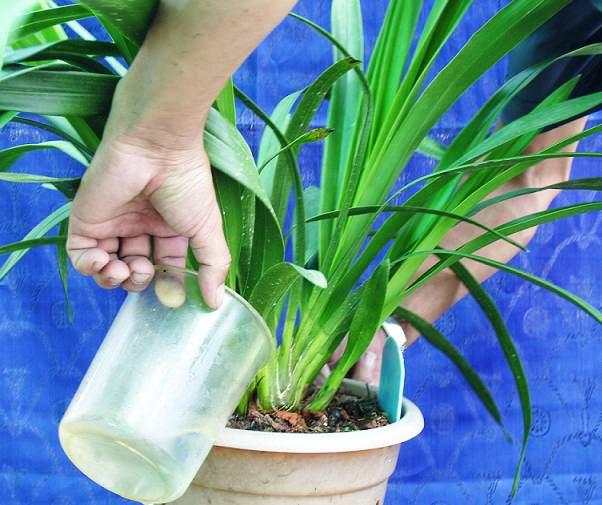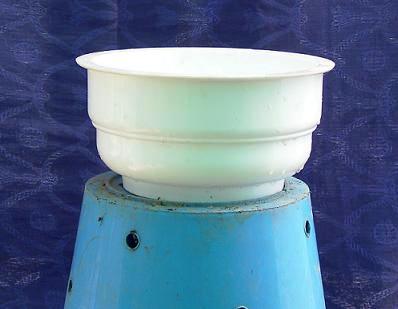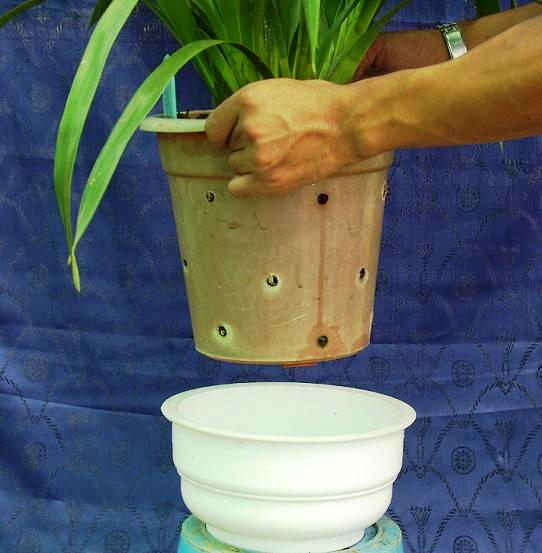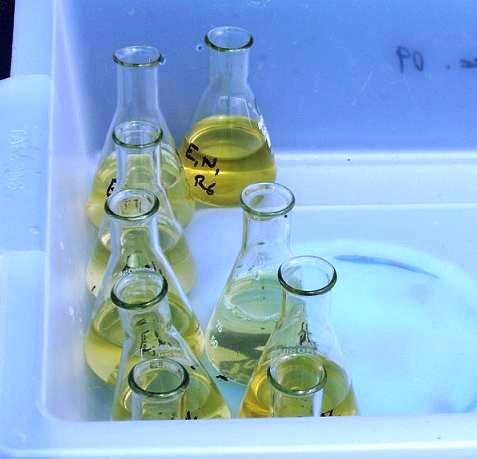पोर थ्रू निष्कर्षण विधि का उपयोग कर फूलों की फसलों की पीएच और ईसी की माप
Providing a proper nutritional program is essential for growing top quality plants. Sampling the root substrate for pH and electrical conductivity (EC) with the PourThru extraction method is a quick and simple.
The pour-through method has been shown to be as satisfactory as other more expensive and time consuming methods of measuring EC. Unlike sampling methods that require removal of medium from containers, the pour-through method does not disturb plant roots.
The values provide clues about a crop’s performance before deficiency or toxicity symptoms appear. As nurseries implement more environmentally and economically sound growing regimes, the pour-through method should become more widely used by foliage growers for self-determination of EC levels periodically during the crop production cycle.
Since many foliage plants can be grown satisfactorily with a wide range of fertilizer rates. The best fertilization rate, from an environmental and economic standpoint, cannot always be determined by visual inspection.
Even though excess fertilizer may not harm some plants, excess nitrogen (N) and phosphorous (P) elements can be lost through leaching and eventually contaminate groundwater.
Growing regimes designed to have minimum detrimental impact on the natural environment should include only enough fertilizer for good plant growth, combined with irrigation practices that limit or eliminate leachate formation.
Environmentally optimum fertilization rates can be determined by monitoring growing medium pH and electrical conductivity (EC) levels. The PourThru extraction method allows rapid on-site determination of pH and EC values. Very few nursery operators regularly monitor the nutritional status of their container-grown plants.
Nursery producers have been slow to accept this technology for the following reasons: 1) lack of uniformity in testing procedures, 2) limited experience by nursery operators in the area of applying results, and 3) cost of testing procedures or equipment.
Two simple tests that can be performed at the nursery are pH and soluble salts measurements (EC). Reliable instruments are now available in a price range that most any nursery operator can afford.
Sampling procedure
Collection of leachate
- Irrigate the crop one hour before testing. The substrate must be saturated. If the water supplied by automatic irrigation system varies, then the pots/flats are watered by hand. If using constant liquid feed, usual fertilizer solution should be applied. If using periodic feeding: a) irrigate with clear water, b) test a day or two before fertilizing, and/or c) test on the same day in the fertilizing cycle each time.
- Place saucer under container. After the container has drained for 30 to 60 minutes, a plastic saucer is placed under the containers to be sampled. If testing is done for seedlings in bedding plant flats, cell packs are placed in saucers.
- Pour enough distilled water on the surface of the substrate to get 50 ml of leachate in the saucer. The amount of water needed will vary with container size, crop, and environmental conditions.
- Collect leachate for pH and EC. Atleast 50 ml of leachate should be collected for test. Leachate volumes over 60 ml will begin to dilute the sample and give lower EC readings.
- Calibrate pH and EC meters prior to testing. The test results are only as good as the last calibrations. The instrument is calibrated every day, they are used. Always fresh standard solutions are used.
- Test your samples for pH and EC. Test the leachate as soon as possible. Electrical conductivity will not vary much over time if there is no evaporation of the sample. However, the pH can change within two hours. Record the values on the chart specific to each crop.
Pour-thru extraction method
Steps in the measurement of nutritional status in the growing media of Orchid
| 1. Irrigate the crop thoroughly one hour before testing | 2. Container for leachate collection |
|
3. After one hour pour enough distilled water on the surface of the substrate to get 70 ml of leachate in the container |
4. Collection of pour-thru leachate |
|
5. Samples ready for measurement of pH, EC and nutritional status
Managing Substrate pH
Substrate pH is very important to plant nutrition because it directly affects the availability of many nutrients, especially micronutrients. A pH meter measures the H+ ion concentration of the solution.
The instrument requires to be calibrated before use with buffer solutions of known pH values. Low pH (below 5.8) can increase micronutrient availability, such as iron and manganese that can lead to phytotoxic responses.
In contrast, a pH above 6.8 can lead to micronutrient deficiency problems, especially with iron. Both excessively low and high pH’s should be avoided. Optimal pH ranges for many crops are listed in Figure 1.
Figure 1. Suggested substrate pH ranges for specific floricultural crops grown in soilless substrate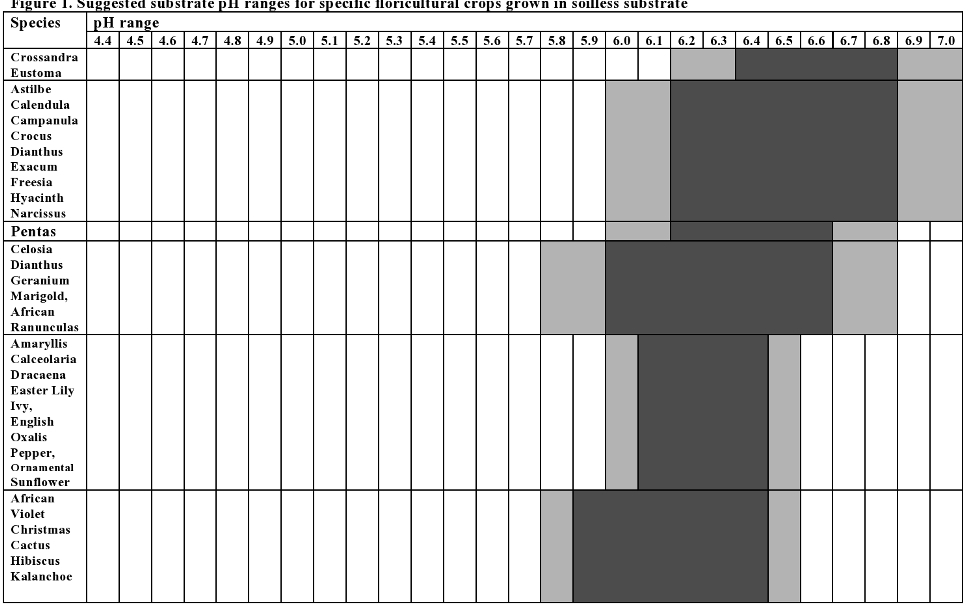
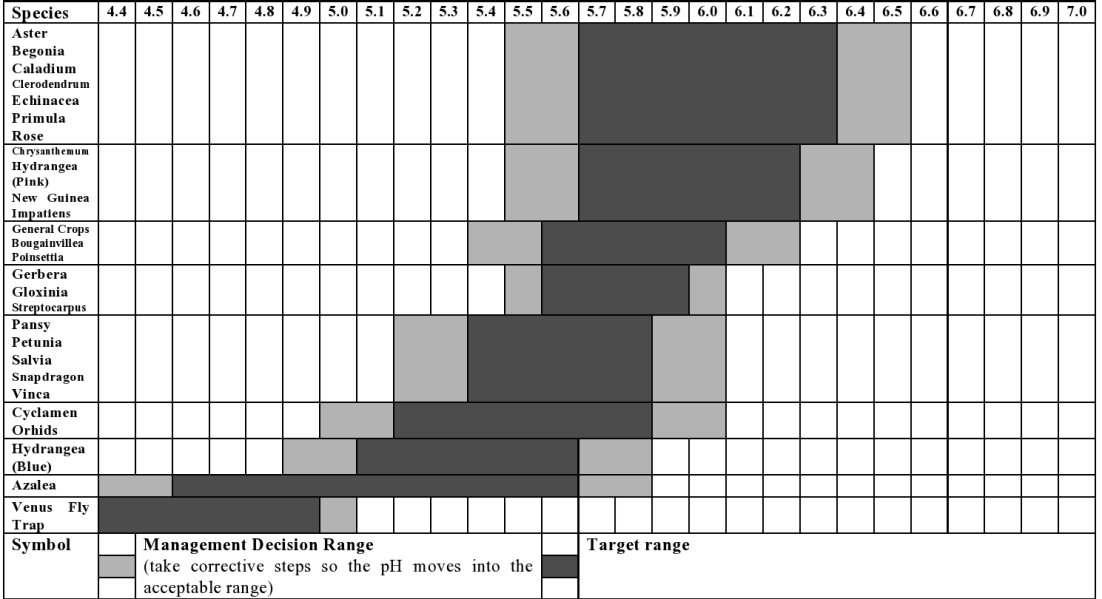
Adjusting substrate pH
Substrate pH changes over time due to many factors. The four main factors affecting substrate pH are (1) the initial components and amendments in the substrate, including the liming charge; (2) the alkalinity of the irrigation water; (3) the fertilizer(s); and (4) the species being grown.
Lowering substrate pH:
The following steps are followed to lower substrate pH:
- Application of acidic (ammonium-based) fertilizer should be followed.
- Acidification of the irrigation water to get pH of 5.8
- Application of iron sulfate (FeSO4·7H2O) drench using 3g per liter of water (0.3%).
Increasing substrate pH:
The following steps are followed to increase substrate pH:
- Neutralization of the alkalinity of the irrigation water should be stopped (if currently acidifying your water).
- Application of basic (nitrate-based) fertilizers should be done.
- Application of a flowable limestone (0.25%) drench.
Managing Substrate EC
Soluble salts are the total dissolved salts in the root substrate (medium) and are measured by electrical conductivity (EC). A conductivity meter measures the passage of electrical current through a solution.
The higher the EC, the easier it is for electric current to move through the solution. The EC of the substrate provides insight to the nutrient status of the crop. All salts measured by an EC meter are not fertilizer salts. An EC meter measures all salts in a solution, but does not provide details on the type or amount of each salt present.
Excess salts can accumulate when: (1) leaching during irrigation is insufficient, (2) the amount of fertilizer applied is greater than what is required by the plant, or (3) the irrigation water contains a high amount of dissolved elements.
Excessively high EC values are associated with poor shoot and root growth. Symptoms often begin on the lower leaves as chlorosis and progress to necrotic tips and margins. As the root substrate dries to the point of irrigation, plants may exhibit wilting symptoms because of die-back of the root tips, which further inhibits water and nutrient uptake.
Figure 2 contains the target EC levels for establishment, active growth, and bloom stages of growth for plants using the PourThru extraction method.
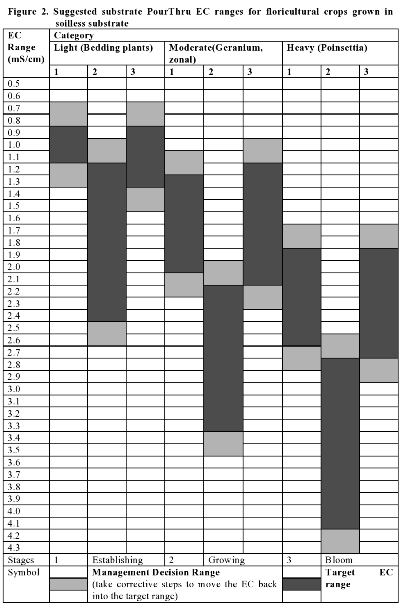
Adjusting substrate EC
The substrate EC changes over time due to many factors. The four main factors are: (1) the initial components and amendments in the substrate, including the substrate type and initial nutrient charge, (2) fertility regime, (3) the crop’s nutrient demands, and (4) the crop’s development stage.
Steps to lower EC
- The fertilization rate or the frequency of fertilization (irrigate with clear water) should be decreased.
- Leaching with clear water to reduce the salts level. The root substrate should be irrigated allowing for 20% leaching, then followed immediately with another irrigation. The root substrate should then be allowed to dry to the usual stage. If further leaching is required, the double-irrigation treatment can be repeated. The EC values should be rechecked to make sure they are within the acceptable range.
Steps to increase EC
- Increasing the fertilization rate. A corrective N fertilization will return the lower leaves to the normal green color within 1 to 2 weeks. It is important to correct nutrient deficiency when symptoms first appear because lower leaf drop or necrosis cannot be reversed.
- Increasing the fertilization frequency. Application of constant fertilization and discontinuing any clear water irrigations until the EC levels are within the acceptable range.
SUMMARY
The PourThru monitoring and managing program is designed for growers to monitor and maintain their crops. It is a simple program for rapidly determining a crop’s pH and EC.
It is a program that allows growers to change their focus to prevention instead of cure, and action instead of reaction. If adopted, this proactive program can virtually eliminate nutritional problems.
Authors:
Sushanta Kumar Naik
Senior Scientist (Soil Science)
ICAR Research Complex for Eastern Region, Research Centre,
Ranchi, Plandu-834010, Jharkhand

